Home>Production & Technology>Music Theory>Music Theory When To Use Double Sharps


Music Theory
Music Theory When To Use Double Sharps
Published: January 30, 2024
Learn when to use double sharps in music theory and enhance your understanding of note alterations. Gain insights on how this advanced concept can enhance your compositions.
(Many of the links in this article redirect to a specific reviewed product. Your purchase of these products through affiliate links helps to generate commission for AudioLover.com, at no extra cost. Learn more)
Table of Contents
Introduction
Welcome to the world of music theory! If you have ever delved into the intricacies of music notation, you may have come across the term “double sharp.” While sharps and flats are common musical elements, the double sharp adds an extra layer of complexity to the mix.
In this article, we will explore the concept of double sharps in music theory. We will discuss what they are, when to use them, and the challenges they present. Whether you are a seasoned musician, a music student, or simply someone with a curiosity for the subject, join us on this journey to expand your understanding of the fascinating world of music theory.
Music theory serves as the backbone of all musical compositions. It provides the framework and rules by which composers and musicians create and interpret melodies, harmonies, and rhythms. Understanding the nuances of music notation is vital for musicians to accurately convey their musical ideas and communicate them effectively to others.
Sharps, which are denoted by the “#” sign, are a tremendously important element in music theory. They raise the pitch of a note by a half step, or one semitone. They can be applied to any of the seven natural notes (A, B, C, D, E, F, G) to create a sharp version of that note. For example, raising the pitch of A gives us the note A#.
However, there are instances in music where the pitch of a note needs to be raised by a whole step, or two semitones, instead of just one. This is where the use of a double sharp comes into play. Let’s dive deeper into this intriguing musical concept.
Understanding Sharps
Before we delve into the intricacies of double sharps, let’s first ensure we have a solid understanding of regular sharps. Sharps are symbols used in music notation to indicate that a note should be raised by a half step, or one semitone. When a sharp is placed in front of a note, it raises the pitch of that note accordingly.
Sharps can be applied to any of the seven natural notes: A, B, C, D, E, F, and G. For example, if we add a sharp to the note C, it becomes C#. Similarly, if we add a sharp to the note F, it becomes F#.
Sharps play a crucial role in music theory as they introduce harmonic tension and lead to the resolution of musical phrases. They allow for the creation of different scales and modes, adding depth and complexity to compositions.
When a sharp is placed in front of a note, it alters both the note itself and any subsequent notes of the same letter name within the same measure. This alteration continues until a natural sign or a different accidental (such as a flat or another sharp) cancels out the effect. For example, if we have the notes C#, D, and E in a measure, the sharp affects both the C# and subsequent D, but not the E. If we want to revert the D back to its natural state, we would need to introduce a natural sign before it.
Understanding the impact of sharps on notes is essential before we explore the concept of double sharps. So, let’s now move on to discussing the fascinating world of double sharps in music theory.
What is a Double Sharp?
A double sharp, denoted by the symbol “x”, is an accidental used in music theory to represent a note that is raised by two semitones or a whole step. It is essentially a sharper version of a sharp. When a double sharp is placed in front of a note, it increases the pitch of that note by two semitones instead of the usual one.
For example, if we start with the note C and add a double sharp, it becomes Cx. This note is two semitones higher than the natural C and one semitone higher than the C#.
The use of double sharps arises in musical compositions when a note needs to be raised by a whole step, but the key signature or the musical context does not allow for it to be notated simply as a natural or a sharp. Instead, the double sharp is used to accurately convey the required pitch alteration.
Double sharps can be applied to any of the natural notes, just like regular sharps. However, they are more commonly used with notes that are already sharpened, such as C#, D#, F#, G#, and A#, to further raise their pitch by a whole step. For instance, if we have the note F# and need to raise it by a whole step, we would use a double sharp, resulting in Fx.
It’s important to note that like regular sharps, the effect of a double sharp continues until it is canceled out by a natural sign or a different accidental. For example, if we have the notes Cx, D, and E in a measure, the double sharp affects both the Cx and the subsequent D, but not the E. To cancel out the double sharp’s effect on the D, we would need to introduce a natural sign before it.
The concept of a double sharp may seem complex at first, but it is a valuable tool in music notation that allows composers and musicians to precisely indicate pitch alterations when necessary.
Instances when a Double Sharp is Used in Music Theory
The use of a double sharp in music theory is not a common occurrence, but it serves a specific purpose in specific musical situations. Let’s explore some instances when a double sharp is used:
1. Modulating to D# Major or E♭ Major:
In music theory, it is common to use the relative major and minor keys to modulate or transition between different tonalities. Modulating to D# major or E♭ major, which have six sharps in their key signature, may require the use of double sharps to indicate the raised pitch of certain notes. For example, if we are modulating to D# major and encounter the note C, it should be written as Cx to accurately represent the raised pitch.
2. Enharmonic Equivalents:
Enharmonic equivalents refer to two notes that sound the same but have different names due to spelling differences. For instance, G# and A♭ are considered enharmonic equivalents because they produce the same sound on the piano keyboard. In some instances, a note may be enharmonically equivalent to a double sharp. For example, the note Fx is enharmonically equivalent to the note G natural. The use of a double sharp in these cases helps to clarify the specific harmonic or melodic intent of the composer.
3. Chromatic Movement:
In chromatic passages or sequences where the pitch moves by half steps, a composer might choose to use a double sharp to maintain consistency in notation. This can eliminate the need for frequent accidentals or conflicting note spellings within a passage. For example, in a chromatic run from C# to D# to E, notating the D# as Dx can simplify the notation and make it easier to read.
4. Augmented Chords:
Augmented chords are chords that feature a major third and an augmented fifth interval. In certain inversions or chord progressions, using a double sharp can enhance the harmonic progression by creating tension or highlighting certain chromatic movement. For example, an F double sharp in the key of C major can be used to create an augmented fifth in an F augmented chord.
These are just a few instances where a double sharp may be utilized in music theory. It’s worth noting that in most musical compositions, the use of double sharps is rare, and composers strive to notate music in a way that is clear, readable, and consistent with the established key signature. However, in specific harmonic or melodic contexts, the use of a double sharp allows for precise communication of pitch alterations and enharmonic distinctions.
Analyzing Chord Progressions with Double Sharps
Chord progressions form the backbone of music, providing the harmonic structure and movement that underlies melodies and gives them context. The use of double sharps in chord progressions can add complexity and color to the music, creating intriguing tonal shifts and harmonic tension. Let’s explore how double sharps can be used in chord progressions:
1. Altered Chords:
Double sharps are commonly used in altered chords, which are chords that feature modified intervals or non-diatonic pitches. These chords often create dissonance and add tension to a progression before resolving to a more stable chord. For example, in the key of C major, an altered G chord with a double sharp 5th (Gx) could be used to create heightened dissonance and add a unique flavor to the progression.
2. Secondary Dominants:
In music theory, secondary dominants are chords that are not within the current key but are temporarily borrowed from another key to create harmonic tension and lead to a resolution. The use of double sharps can come into play when dealing with secondary dominants. For instance, in the key of C major, a secondary dominant chord leading to the dominant (G) could be an A double sharp major chord (Ax). This temporary alteration adds a dramatic and intense sound to the progression.
3. Modal Borrowing:
Modal borrowing involves incorporating chords or notes from a parallel or related mode into the current musical context. The use of double sharps may be necessary when borrowing from certain modes that require pitch alterations. For example, borrowing an F double sharp chord from the key of D# major and incorporating it into the key of C major can create an exotic and unexpected tonal color.
4. Chromatic Progressions:
Chromatic progressions involve a series of chords where each successive chord moves by half steps. Double sharps can be used to maintain the consistency and accuracy of the chromatic movement. For example, in a chromatic progression from C# to Dx (E natural) to Ex (F#), the double sharp ensures that the interval between Dx and Ex is a half step, creating a smooth and logical chromatic line.
Analyzing chord progressions with double sharps requires an understanding of the underlying harmonic principles and the ability to recognize and interpret the specific role that each chord plays within the progression. By incorporating double sharps strategically, composers and musicians can create unique and captivating chord progressions that push the boundaries and add a sense of depth and intrigue to the music.
Challenges of Using Double Sharps
The use of double sharps in music theory comes with its own set of challenges and considerations. While they serve a crucial role in accurately notating pitch alterations, they can pose difficulties and require careful attention. Let’s explore some of the challenges of using double sharps:
1. Readability and Interpretation:
Double sharps may complicate the readability of sheet music, especially for performers who may need to quickly interpret and execute the music. The presence of double sharps requires musicians to be familiar with the specific note alterations and be able to apply them accurately and efficiently while sight-reading or performing the piece.
2. Enharmonic Confusion:
Enharmonic equivalence refers to notes that sound the same but are spelled differently. The use of double sharps can lead to enharmonic confusion, as a note notated with a double sharp may have an enharmonic equivalent that is notated differently. This can sometimes cause confusion or hesitation when musicians encounter these notations.
3. Mental Calculation and Transposition:
When working with double sharps, musicians may need to mentally calculate or transpose the music into a different key signature or mode. This requires a solid understanding of music theory principles and the ability to quickly adapt and apply pitch alterations to the appropriate notes within the new context.
4. Contextual Accuracy:
Using double sharps accurately requires careful attention to the musical context. It is essential to ensure that the use of a double sharp is justified and does not create conflicts within the key signature or contradict the overall harmonic structure of the music. Composers and musicians must consider the impact and effect of double sharps on the overall musical composition.
5. Communication and Collaboration:
When working with others, such as fellow musicians or music editors, the use of double sharps may require additional explanation and communication to ensure a clear understanding of the intended musical notation. Collaborative efforts may involve discussions to clarify any potential confusion, especially if the use of double sharps is relatively rare or unconventional within the specific musical genre or style.
While the challenges of using double sharps in music notation are present, they can be overcome with practice, familiarity, and a solid understanding of music theory. As composers and musicians become more comfortable with the concept and its applications, they can effectively utilize double sharps to enhance their musical compositions, adding depth, tension, and unique tonal colors.
Conclusion
Double sharps add an intriguing layer of complexity to music theory. While they are not commonly used in most compositions, they serve a specific purpose in certain musical contexts. Understanding how and when to use double sharps is crucial for composers, musicians, and music enthusiasts.
We have explored the concept of double sharps, their role in raising a note by two semitones or a whole step, and their various applications in music theory. From modulating to different keys and creating harmonic tension to enhancing chord progressions and adding unique tonal colors, double sharps offer a range of possibilities for musical expression.
However, it is important to be aware of the challenges that come with using double sharps, such as readability, enharmonic confusion, mental calculation, and effective communication. These challenges can be overcome with practice, a solid understanding of music theory, and open collaboration with others in the music-making process.
Ultimately, the use of double sharps is a tool that allows composers and musicians to accurately convey complex pitch alterations and bring their musical ideas to life. With careful consideration and a keen ear for harmonic intricacies, the inclusion of double sharps can elevate a composition and captivate listeners.
So, the next time you encounter a double sharp in your musical journey, embrace its unique character and explore the possibilities it presents. Let the double sharp be your guide on a musical adventure filled with tension, resolution, and artistic expression.











